MACROECONOMICS IN JAPAN
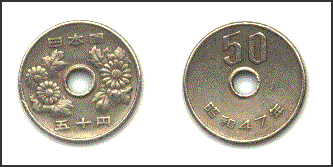
50 yen coins Domestic demand and consumer spending accounts for nearly 60 percent of Japan’s GPD. In recent years growth has been spurred by exports, particularly to China and the United States. For Japan to really get its economy going it needs to generate more consumer spending and rely less on exports for growth to maintain momentum and to provide insurance in the event the economies in China and the United States falter.
For decades, the goal of Japan was to catch up with the West. Since that was achieved in the 1980s, Japan has been somewhat adrift. Opinion polls show that more Japanese are pessimistic than optimistic about the future. There are worries rising debt could cause a confidence crisis that could cause a flight of capital and currency turmoil. If something isn't done Japan could fall into a depression or experience hyperinflation.
Manufacturing accounts for a fifth of Japan’s GDP. "In global markets," writes Andrew Pollack of the New York Times, "future gains by Japanese companies will not come easily, in part because rivals have caught up. In industries like automobiles and semiconductors, Japan's advantage based on manufacturing efficiency has been narrowed."
Some think that post-bubble economy years been good for Japan. In that time the Japanese have become more creative, individualist and flexible — not just company slaves. A spirit of rebellion has arisen that has fostered creativity and a lively youth culture. Some economists believe that Japan can maintain economic growth even as its population decreases if the work force remains productive and innovative.
In recent years, according to the New York Times, the Japanese economy has been changing in three important ways: 1) Japan is relying more for growth on booming Asia and less on the mature markets of the United States and Europe; 2) it is moving from manufacturing towards service and information-based industries; 3) it will fuel growth by consuming more at home instead of exporting its products.
The Japanese economy is vulnerable to high oil prices, currency swings and the impact on financial markets of terrorist attacks and wars. Low growth figures aren’t as bad in Japan as other countries because the population is hardly growing — even shrinking — and most people already enjoy a relatively high standard of living.
To be competitive in the global market, Hiromasa Yonekura, the head of the Japan Business Federation (Keidanren), said in September 2011 that Japan needs to internationalize its workforce, especially through work force exchange sin Asia, and the government needs to reduce the corporate tax from 40 percent to 25 percent.
Websites and Resources
Good Websites and Sources: Book: “Macroeconomics and the Japanese Economy” (1995) questia.com/library/book ; Paper: Japanese Macroeconomic Dilemmas pdf file wlu.edu/~smitkam ; Macroeconomics Policy Options (2002) iie.com/publications ; Book; The Holy Grail of Macroeconomics, Lessons from Japan’s Great Recession wiley.com/WileyCDA ; Japan Watch, Commentary on Political and Economic Issues jipr.org ; Japan Policy Research Institute jpri.org ; Institute for Monetary and Economic Studies, Bank of Japan imes.boj.or.jp ; Keidanren (Most Powerful Business Group in Japan) keidanren.or.jp ; Keizai Koho Center, Keidanren’s Research Arm kkc.or.jp/english ; Daiwa Institute of Research dir.co.jp/english ; Bank of Japan www.boj.or.jp/en
Links in this Website: STATISTICS AND MONEY IN JAPAN Factsanddetails.com/Japan ; MACROECONOMICS IN JAPAN Factsanddetails.com/Japan ; JAPAN INC. AND REFORMS Factsanddetails.com/Japan
Good Websites and Sources on Economics: Ministry of Economy, Trade and Industry meti.go.jp/english ; Ministry of Finance of Japan mof.go.jp/english ; Japan Economy News and Blog japaneconomynews.com ; Japan Economy Watch japanjapan.blogspot.com ; Japan Center for Economic Research jcer.or.jp/eng ; Japan Inc. Economic and Business News japaninc.com ; Google E-Book: Japan in the 21st Century, Environment, Economy and Society (2005) books.google.com/books
Mature Economy of Japan
The Japanese economy is regarded as a mature economy. According to Investopedia, “a mature economy is the situation where the country's population has stabilized or is in decline, and where the pace of economic growth has also slowed. A population has stabilized or is in decline when the birth rate is equal to or less than the mortality rate. A mature economy is characterized by a decrease in spending on infrastructure, and a relative increase in consumer spending.”
Nathan Gardels, editor-in-chief of NPQ and the Global Viewpoint Network, wrote: “Japan has been wallowing in stagnation for years despite massive government stimulus programs and zero-interest rates because, simply put, in such an advanced, mature economy there was too little demand to generate sufficient returns to attract private investment. Thus the famous “bridges to nowhere” and other projects that amounted to pushing a string.”
Although the economy as a whole seems to be stagnating or in decline there are lots of little niche areas for growth such as: 1) nursing homes, meal delivery services and other businesses that cater to Japan’s aging populations; 2) fast food and bento boxes as Japanese want speed and convenience; and 3) cheap retail outlets such as Uniqlo clothes and Nitori furnishing that offer reasonably quality stuff for low prices. Other promising and growing sectors include drugs and Internet commerce. Land prices in Japan fell for the 20th year in 2011. Prices fell by 3.2 percent and were adversely affected by the March 2011 earthquake and tsunami according to Japan’s land and infrastructure ministry.
Population and Economics in Japan
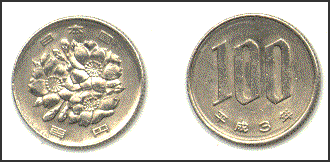
100 yen coins One of Japan's biggest problems as it approaches the future is a low population growth rate and a lack of immigration. Growth has been hurt by an aging population and a mature economy. A declining population also means Japan will have to increase productivity dramatically to maintain current living standards and there will be less consumers and less tax revenues.
Low growth figures aren’t as bad in Japan as other countries because the population is hardly growing — even shrinking — and most people already enjoy a relatively high standard of living. In addition, Japan's high savings rates are a good thing in country with with an ageing populations because it shows that people are willing to defer growth for now in return for security in the future.
In 2007, the Japanese Labor Ministry projected 10.7 million fewer jobs in 2030, mainly because of birthrate decline. A crisis looms as the old population demands pensions and health care. Reform is also needed in the pension system to give households more confidence to spend their vast savings.
Japanese companies are very worried about a lack of skilled labor in the future. As the Japanese baby boomers begin retiring in mass — a process that began in 2007 — there are concerns there will not be enough people, especially ones with their skills, to replace them.
The work force will shrink by as much as third by 2050, when it is predicted there will be more people not working than working (49.5 million people working out of a population of 100 million). Before 2050 an average of 620,000 people will leave the work force every year. Recommendations to address this problem include raising the retirement age to 65; improve child-care services so more women can work; and allowing more immigrants to work in Japan.
Population Declines and the Japanese Workforce

500 yen coins There is growing concern over the consequences that the aging of Japanese society will have for the economy. In 2011 approximately 23 percent of the population was 65 or older, but by 2055 this figure is projected to be about 41 percent. To minimize the effects of the contraction of the working population, it will be necessary to both increase labor productivity and to promote the employment of woman and people over 65. In addition, fundamental reforms will be necessary in pension and other social welfare systems in order to avoid large inequalities between generations with respect to the burdens born and benefits received.
A declining birthrate and an older population means that as time goes on there will more retired people and relatively less working people, which means that working people are increasingly called upon to support the retirees with their labor. Between 1985 and 2005 the number old elderly doubled while the number of children fell by a third. By one count the Japanese workforce will shrink by 6.1 million by 2025. This will put a lot pressure on younger people to take care of older people. Japan will have allow large numbers of immigrants in if it wants to maintain economic growth.
The work force is expected to fall 15 percent over the next 20 years and halve in the next 50 years. Currently, about 70 percent of the population in Japan is of working age. By 2025, if current trends continue, the figure will drop to 60 percent. That means that in 2025 three working people will not only have to support themselves they also have to support two people who aren't working. By 2050 population loss will strip Japan of 70 percent of its workforce.
A shrinking, graying population is likely to cause the economy will shrink. There will be fewer skilled people entering the job market. There will be less savings. This means there will be less money for loans and investmnet and this will make it harder for companies to grow and create new jobs for young people.
Japan’s aging population is also widely seen as an obstacle to innovation. As the population gets older and fewer young people are born there are less young people around to come up with fresh new ideas and more cranky old people around to pooh pooh the fresh ideas that appear.
Japan will probably have allow large numbers of immigrants in if it wants to maintain economic growth.
Favoring the Old Over the Young and New in Japan
Martin Fackler wrote in the New York Times, “As this fading economic superpower rapidly grays, it desperately needs to increase productivity and unleash the entrepreneurial energies of its shrinking number of younger people. But Japan seems to be doing just the opposite. This has contributed to weak growth and mounting pension obligations. “There is a feeling among young generations that no matter how hard we try, we can’t get ahead,” said Shigeyuki Jo, 36, co-author of “The Truth of Generational Inequalities.” “Every avenue seems to be blocked, like we’re butting our heads against a wall.” [Source: Martin Fackler, New York Times, October 16, 2010]
“An aging population is clogging the nation’s economy with the vested interests of older generations, young people and social experts warn, making an already hierarchical society even more rigid and conservative. The result is that Japan is holding back and marginalizing its youth at a time when it actually needs them to help create the new products, companies and industries that a mature economy requires to grow.”
“A nation that produced Sony, Toyota and Honda has failed in recent decades to nurture young entrepreneurs, and the game-changing companies that they can create, like Google or Apple — each started by entrepreneurs in their 20s.”
Centralization in Tokyo and Looking to Asia
In Japan there is an extraordinary concentration of economic power in Tokyo. The greater Tokyo region represents one-third of the nation’s economic output. Marcus Noland wrote in the Washington Post, “Over the past 10 to 20 years, hundreds of Japanese corporations have moved their headquarters from cities such as Osaka and Kitakyushu to the Japanese capital. The nation’s transition to a post-industrial society (with its greater emphasis on white-collar services), the decline of regional financial institutions and a cultural emphasis on face-to-face communication in business have encouraged the clustering of economic life in Tokyo. But post-earthquake rebuilding could help spread economic activity across the country. If pursued creatively, this could help jump-start an entirely new source of economic strength in northern Japan. [Source: Marcus Noland, Washington Post, March 16, 2011]
Japanese businesses are beginning to look more and more towards Asia for growth potential than North America and Europe. They are also looking more to new markets in emerging nations as sales in Japan and the developed world fail to grow.
In 2010, Japan was surpassed by China as the world’s No. 2 economy. This is not all that significant when you consider that China’s population is ten times larger than that of Japan and thus on a per capita basis the Chinese economy is only on tenth as large as the Japanese economy. Overall China’s growth is good news for Japan as it means there is a huge market for Japan just offshore.
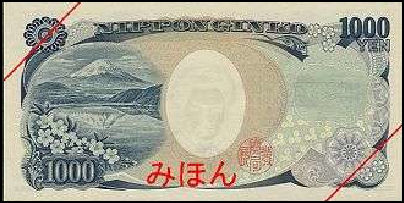
back of new 1,000 yen banknote
Kyushu Eyes Asia to Boost Economy
Shanghai is about 810 kilometers from Nagasaki, less than the 960 kilometers that separate Tokyo and Nagasaki. Fish exports from Nagasaki increased from about 5 million yen in 2005 to 240 million yen in 2010. While domestic demand remains sluggish, the Nagasaki prefectural government is trying to use seafood to work its way into the Asian market, as the prefecture is known for fish. "We'll take advantage of our location to revitalize ourselves with the vitality of other Asian countries," said an official of the fishery processing and distribution office of the Nagasaki prefectural government. [Source: Yomiuri Shimbun, March 5, 2012]
An attempt to increase external demand has been under way through cruise ships from other Asian countries visiting the Kyushu region and high-speed ships connecting South Korea and Japan. At Hakata Port in Fukuoka, a growing number of cruise ships have been arriving from China. Such ships made port calls to Hakata 61 times in 2010, a sharp increase from just six in 2007. Many ships have already visited the port in 2012 and, according to the Fukuoka city government, each ship brings economic benefits of as much as about 44 million yen.
"Japan will sink unless the Kyushu region, with its geographical advantage, becomes a growth engine centered on the Fukuoka area open to other Asian countries, instead of the Pacific," said Prof. Hirofumi Taniguchi, who specializes in public policy at Kyushu University. He said that with the country's shrinking population and domestic demand, it is necessary to shift from conventional ways of thinking, under which people ask politicians and bureaucrats to provide subsidies or assist in attracting branch offices and company factories.
Local governments in Kyushu envisage growth through exporting urban environment infrastructure such as water treatment plant technology, which Kitakyushu is known for. They also plan to develop eco-friendly products such as advanced semiconductors, eco-friendly vehicles, industrial robots and wind power generation equipment, as well as creating production bases for them.
Oita Gov. Katsusada Hirose, chairman of the association, said at a press conference on Feb. 16, "Although the population of the Kyushu region makes up about 10 percent of the country, its economy accounts for only about 8 percent. Therefore, there is still room for growth in the region." "We'll realize a growth strategy in which the entire Kyushu region will be energized from the growth of other Asian countries," he said.
Taniguchi also stressed that the Kyushu region could become a major hub in Asia if it fosters human resources for information and communications technology, the environment and renewable energy and opens its doors to foreign nationals in those fields.
Osaka’s Decline
The underlying reason Hashimoto and his supporters are calling for the establishment of the Osaka metropolis is their strong sense of crisis over Osaka's current status. In the closing years of the Taisho period (1912-26), the population of Osaka city exceeded that of Tokyo, and people showed their respect to Osaka by calling the city Dai-Osaka (great Osaka). However, the commercial city's influence has declined rapidly in recent years, as the city lacks key industries that can lead to economic development. [Source: Yomiuri Shimbun, March 3, 2012]
Osaka Prefecture's gross nominal product was 37.98 trillion yen in fiscal 2008, the second-largest in the nation following Tokyo's 89.71 trillion yen--but the figure was down 8.5 percent from fiscal 1996. One in 18 residents in Osaka city receive welfare benefits, the highest ratio in the nation.
Among major companies capitalized at 10 billion yen or more, 99 of them were headquartered in Osaka in 1999, but the figure dropped to 72 in 2009. The main reason for the decrease is attributed to overconcentration in Tokyo, and it is not clear whether the "ineffective governing system" caused by the coexistence of Osaka's prefectural and municipal governments contributed to the decrease.
Osaka Mayor Toru Hashimoto attributed the decline of Osaka Prefecture to the lack of a "commander-in-chief" designing and promoting its urban development, as two huge government offices--one for the prefecture and the other for the city--coexist in the second-smallest prefecture in the country. Hashimoto thinks that if the power and revenue of the prefecture and the two ordinance-designated cities were integrated into one, it would be possible for the Osaka metropolis to develop railroads and roads more efficiently, which would lead to the revival of "great Osaka."
Creating a 'Great Osaka' that Can Compete with Tokyo
Osaka Mayor Toru Hashimoto's plan to integrate the prefectural and municipal governments of Osaka. "We can reinvigorate local areas by changing their governmental structures,” he said at a ceremony held in December 2011 to inaugurate the headquarters for the integration of the prefectural and municipal governments of Osaka. [Source: Yomiuri Shimbun, March 3, 2012]
The headquarters was established by the two governments as the first step toward realizing Hashimoto's plan to transform Osaka into a metropolitan administrative unit like Tokyo, following landslide victories by Hashimoto's party in the Osaka gubernatorial and mayoral elections in November. Hashimoto, head of the Osaka Ishin no Kai (Osaka restoration group) party, won the mayoral election, while the party's Secretary General Ichiro Matsui grabbed the Osaka governor spot.
The integration headquarters will work comprehensively on industrial policies and urban development projects of Osaka Prefecture and Osaka city, among others, which had been undertaken separately by the prefectural and municipal governments. Its opening marks the first time a prefecture and an ordinance-designated city have established a joint policymaking institution.
Hashimoto and Matsui plan to secure 400 billion yen annually through cost cuts, especially in areas such as the duplication of administrative tasks of the governments. They want to allocate the money to sectors expected to expand in the future at the integration headquarters, which some see as a precursor for the envisaged "Osaka metropolitan government." The prefectural and municipal governments of Osaka have decided to let the integration headquarters work on projects such as managing public hospitals and universities in an integrated manner; designing a redevelopment zone located in front of JR Osaka Station; and privatizing the Osaka municipal subway. Hashimoto and Matsui want to show the benefit of integrating the prefectural and municipal governments by achieving consistent results, gaining momentum to achieve their goal of creating the Osaka metropolis in the spring of 2015.
After integration, the cities of Osaka and Sakai will be divided into 10 to 12 special administrative units (wards) with the heads of the units and assembly members elected by popular vote. The administrative units will be in charge of providing welfare, education and other public services.
However, many officials of the Internal Affairs and Communications Ministry say a plan advocated by the association of mayors from ordinance-designated cities to give de facto independence to major cities is more realistic than Hashimoto's Osaka metropolis project. Moreover, it is unclear whether there is a cause-and-effect relationship between the current central government's system on big cities and their economic vitality.
Trade Surpluses, Tariffs and Protectionism in Japan
One of the main contributors to Japan's phenomenal growth over the past half century or so has been its extraordinary trade surpluses, helped in part by high tariffs to keep foreign imports out and tax-free saving and other incentives to make sure the banks lent money to companies at low interest rates to fuel production. Japanese citizens did their part over the years by buying domestic products even though they often sold for outrageously high prices. Japanese companies made copies of all the goods that foreign companies might want sell in Japan. When Mars introduced M&Ms in 1973, 25 Japanese imitations were available in six months.
The traditional Japanese formula was to import raw material, produce manufactured good and export them at a higher price. Companies invested abroad but only to supply foreign markets and grew, in some cases, through dumping and ruthlessly seizing market shares. The government protected domestic industries such as farming, banking and small businesses for social and political reasons. In the 1980s, it was illegal for Japanese to import and sell rice.
One former Ministry of Finance bureaucrat old Time, "My duty was to prevent foreign companies from coming into the market." He said he achieved this goal by bogging down foreign companies with paper work and making "a very detailed examination so that it took ages."
Japan has a trade surplus with almost every developed nation in the world. Japan's share of world exports reached their peak in 1986. Since them, of the 1,618 international trade industries that Japan participates in, the export share of 1,250 of these companies declined while only 166 have risen.
Exports and trade surpluses remain essential to Japan’s growth. The period of growth from 2002 to the end of 2006, the longest in the postwar period, was largely driven by exports which rose as proportion of GDP from 10.4 percent to 15.6 percent. In recent years high fuel and material costs have trimmed Japan’s trade surplus. A decline in exports caused by global financial crisis in 2008 and 2009 turned a trade surplus into a trade deficit reached a record ¥952.6 billion in January 2009.
In 2008, exports made up 15.9 percent of GDP, compared to 9.8 percent in 1998. High growth rates in China and India and the rest of Asia bode well for Japan. As people in these countries become more affluent there will be an increase in demand for Japanese products. As time goes on Japan will rely increasing on markets from these countries and less from those in the United States and Europe.
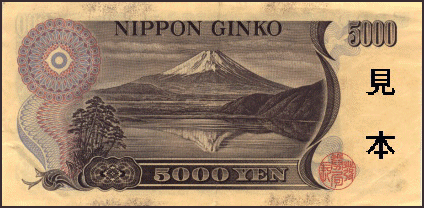
back of old 5,000 yen banknote
Energy and Economics in Japan
Japan is one of the most energy efficient countries in the world and is known for getting the most out of its valuable oil. Japan needs half as much oil as the United States to generate $1 worth of economic growth. The average Japanese spends 1 percent of its household budget on gasoline compared to 3 percent for Americans. Many industries rely on high technology rather than fuel to keep them going.
Japan has no oil of its own and very little coal or other energy sources. It is at the mercy of oil and energy prices not so much because it relies on oil to keep its factories humming, which is true, but it also relies on oil to keep economies in other countries humming so they can buy Japanese products.
Japan as worked hard to become energy efficient after being thrown into dire straits by the oil embargo in the 1970s. Between 1958 and 1970s energy consumption is Japan rose at an average of 21 percent every year. During the oil crisis in 1974, there were not long lines of cars at the gas station (many Japanese did not have cars at that time) but there were long lines at supermarkets as people hoarded toilet paper (apparently because they thought the oil shortage would cause toilet paper factories to shut down).
Now Japan is regarded as the world’s No. 1 energy savings nation. It is energy consumption per unit of GDP is the smallest of any nation in the world, half that of the United States and one ninth that of China and India. Japan uses 20 percent less energy to produce a ton of steel than the United States and 50 percent less than China.
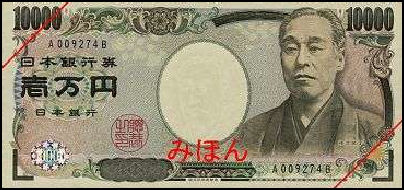
front of new 10,000 yen banknote
Productivity, Loyalty and Regulations in Japan
Japan is famous for its high productivity. In the late 1990s production per capita in Japan was $40,940, compared to $28,020 in the United States and $750 in China.. See Economics, Industry, Toyota, Toyota Productivity
Japanese workers put in long hours yet the have the lowest productivity ratings in the Group of Seven industrialized countries.
Loyalty has traditionally been important in Japanese business. A Washington Post journalist wrote: "One day...I proposed to my Japanese staff that we dump overpriced, underpowered machines that the bureau was leasing from NEC Corp...They responded with drop-jawed horror at the idea of betraying NEC, and I retreated." There are also cozy relations between the government and companies. Government agencies, that are supposed be policing Japanese companies, are often lax, letting companies get away thing they shouldn't.
Japan has complex regulations and real estate laws. Retailing laws in Japan can delay openings, force store to close early, reduce their size, and close a minimum number of days each year. Separate licenses are needed to sell fish, meat, bread, dairy products, pharmaceuticals and dozens of the other products. A rice license is only issued for 1,500 residents, which means that big stores have to buy up licenses from other owners. In recent years some of these regulations have been eased. [Source: New York Times]
As a result of price-fixing and regulations it can cost more to fly from Tokyo to Sapporo than it does from Tokyo to Los Angeles in the low season, and sending cargo from Osaka to the east coast in the U.S. can cost $30 a ton while sending the same cargo from Osaka to Hokkaido can cost $50 a ton and the truck ride from the port to the plant, $100 a ton.
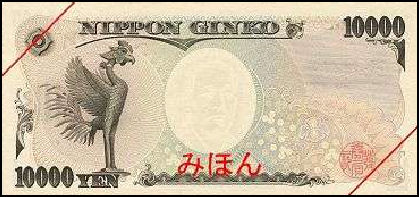
back of new 10,000 yen banknote
Middlemen in Japan
Japan employs many middlemen and has a relatively inefficient distribution system although this less the case now than it once was. Goods often pass through several distributors before they reach the store shelves. The redundant layers of labor are part of social contract to make sure that everyone has a job. In addition, most companies have traditionally had extra layers of labor that would not be found in more "efficient" Western countries.
At the Tsukiji fish market in Tokyo, for example, commerce is dominated by seven major first-tier wholesalers, who bring in the catch from around the world and sell it to thousands of middle whole wholesalers, who in turn sell it again to distributors who deliver the seafood to stores and sushi bars. The fish industry also includes fishermen, traders who purchase the fish, air shipping companies, trucking companies, butchers, packagers, delivery people. On its journey from the sea to the customers plate, a single fish can change hands a dozen times, with each business taking a profit and adding an expense.
Consumers and businessmen put up with high prices and a certain degree of inefficiency because they create jobs and make the Japanese economy stronger. Japan's service sector, with its legions of paper pushers and miles of red tape is especially inefficient. In recent years price competition has forced streamlining of the distribution system, the service sector and Japanese corporations.
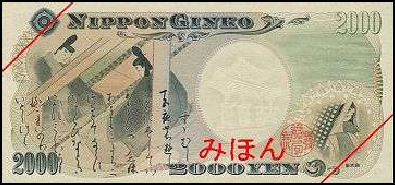
back of little-used 2,000 yen banknote
Japan’s Growing Asian Connection
The share of manufactured goods as a percentage of all Japanese imports has greatly increased since the mid-1980s, exceeding 50 percent in 1990 and 60 percent in the late 1990s, and this has spurred fears of a hollowing out of Japanese industry. Growing trade friction in the second half of the 1980s and the steep rise in the value of the yen impelled many companies in key export industries, notably electronics and automobiles, to shift production overseas. Manufacturers of such electrical products as TVs, VCRs, and refrigerators opened assembly plants in China, Thailand, Malaysia, and other countries in Asia where work quality was high and labor inexpensive. For such products, the market share of imported goods now exceeds that of domestic items. [Source: Web-Japan, Ministry of Foreign Affairs, Japan]
“In recent years, a rapid increase in manufactured imports from China has caused particular concern. Between 2001 and 2005, Japan’s imports from China rose by 170 percent. During the same period exports to China rose by an even faster rate, 235 percent. Moreover, the share of Japan’s trade occupied by China grew to 19.4 percent in 2010,surpassing the 15.4 percent held by the United States to become the largest of any country. Japan’s digital home electronics and automobile-related exports are robust, with total exports to China exceeding the 100 billion dollar level since 2007.
“Since 1988 Japan has run a continuous trade deficit with China. However, a large portion of Japan’s exports to Hong Kong end up being exported to China, and if this is taken into account and Japan-China trade is examined from an export basis, Japan is actually running a trade surplus. The simultaneous increase in the volume of both product exports and imports with China and the rest of Asia is partly the result of an international division of labor occurring as part of manufacturing globalization. Japanese companies export capital goods (machinery) and intermediate goods (components, etc.) to production facilities built through their direct investment in China, and then they import the finished goods back into Japan.
“At present there is still a vertical division of labor, with Japan specializing in knowledge- and technology-intensive modules and processes and China specializing in labor-intensive modules and processes. As China and other developing nations continue to improve their technical capabilities, however, the challenge for Japan’s manufacturing industry will be to maintain a comparative advantage in knowledge- and technology-intensive sectors.
Japan, the United States and China
Japan has traditionally been dependent on the United States as the primary market for Japanese goods. Upturns and downturns in the U.S. economy can result in corresponding upturns and downturns in the Japanese economy.
Japan has became increasingly dependent on China as both a source of cheap labor for the production of Japanese goods and a market for Japanese goods. As time goes the economies of Japan and China have become closely linked, so much so that the slowing of growth in China means low growth in Japan. In recent years Japan has become very reliant on China to keep its economy going.
China’s rise has offered both problems and opportunities. As China gets richer it opens new markets for Japan. Chinese companies have made great advancements and now can produce stuff almost as good in quality as Japanese stuff but costing consumers a fraction of the price. As a result of this many Japanese companies have gone out of business.
Many small Japanese factories are under pressure to cut price or watch their business go to China The tool and die industry has been particularly hard hit. Japanese companies have become concerned, as American companies have, that Chinese companies are stealing their intellectual property.
Image Sources: 1) coins and old banknotes markun.cs.shinshu-u.ac.jp 2) new banknotes Big Globe net and zentech.com
Text Sources: New York Times, Washington Post, Los Angeles Times, Daily Yomiuri, Times of London, Japan National Tourist Organization (JNTO), National Geographic, The New Yorker, Time, Newsweek, Reuters, AP, Lonely Planet Guides, Compton’s Encyclopedia and various books and other publications.
Last updated August 2012
